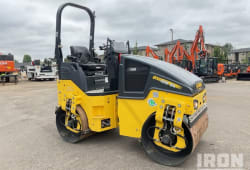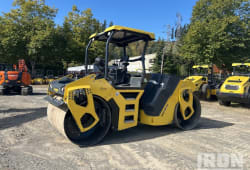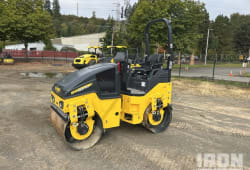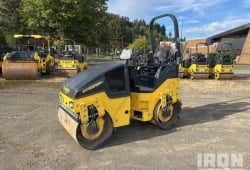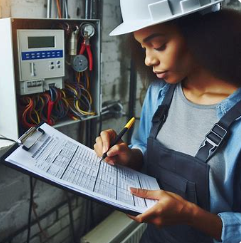Cheapest Alternatives to Compactors: From Selection, to Installing, and Beyond
5 Min read
)
October 16, 2023
For small-scale or occasional projects, investing in heavy-duty compactors can be excessive. Thankfully, there are several economical alternatives that ensure efficient compaction without overspending. This guide outlines ten cost-effective options, ideal for both DIY enthusiasts and professional contractors looking to manage costs effectively. Here we are going to tackle the cheapest alternatives to compactors.
Top Budget-Friendly Compactors
Rammers (Jumping Jacks):
Perfect for compacting cohesive and granular soils, rammers excel in narrow or hard-to-reach areas. Their lightweight design and ease of maneuverability make them ideal for trenches and around existing structures. Rammers deliver focused compaction with depth, making them indispensable on sites with spatial constraints.
Vibratory Plates:
These are essential for small to medium paving projects and can work on both granular and mixed soils. Vibratory plates compact with a combination of weight and vibrations, promoting rapid soil settlement and strength. They are available in single and reversible plate options, allowing for more versatile applications across various soil types.
Hand Rollers:
Small, manual rollers are cost-effective for compacting small patches of asphalt or granular soil. They are easy to operate and highly effective for small driveways, pathways, or minor repair jobs. Despite their manual nature, they provide surprisingly even compaction, essential for maintaining level surfaces.
Sheepsfoot Rollers:
Featuring a drum equipped with numerous "feet" that penetrate the soil, these rollers are particularly effective on clayey soils. The kneading action of the feet induces deep compaction, ideal for preparing sub-surfaces for large structures or roadways. They are often used in larger construction projects where foundational stability is critical.
Tow-behind Rollers:
Attachable to common farm or landscaping vehicles, these rollers are versatile for large, flat areas. Whether you're compacting a new seedbed, smoothing out a sports field, or preparing a large foundation, tow-behind rollers provide uniform compaction over extensive areas without major equipment investments.
Pneumatic Rollers:
Best suited for asphalt compaction, these rollers use multiple rubber tires to knead the material into a dense and smooth layer. Their flexibility allows them to adapt to slight surface variations, ensuring thorough compaction over contours and edges. Pneumatic rollers are essential for road construction and large parking areas where uniformity and surface texture are priorities.
Manual Compaction Tools (Tampers and Compacting Plates):
For very small projects or tight spots, simple hand tools like tampers provide effective compaction. These tools are affordable and straightforward to use, making them perfect for post-hole compaction or small patch repairs in pavements and walkways.
Vibratory Rammers:
An advanced version of standard rammers, these incorporate a vibratory mechanism to enhance soil compaction efficiency. Vibratory rammers are more effective on a variety of soil types, reducing labor intensity and improving compaction depth, which is crucial for utility and plumbing installations.
Vibratory Walk-Behind Rollers:
These compact rollers are powerhouses for medium-sized areas needing soil or asphalt compaction. Their design combines weight with vibrational force, making them more efficient than manual rollers, particularly on cohesive soils or for compacting next to walls and other infrastructure.
Roller Rental Services:
Renting compaction equipment provides a flexible and cost-effective solution for project-specific needs. This option is excellent for occasional use, allowing access to professional-grade equipment without the full investment, perfect for seasonal or one-off projects requiring higher-grade compaction.
Tips in Choosing the Right Compactor
Assess the Project:
Begin by thoroughly evaluating the specific needs of your project. Determine the type of materials you will be working with (soil, asphalt, etc.), the total area that requires compaction, and the desired depth of compaction. Understanding these elements will help guide your selection process towards the most suitable equipment.
Compare Options:
Research the different types of compactors available, such as rammers, rollers, and plate compactors. Consider how each option aligns with the specifics of your project, focusing on aspects like machine efficiency, suitability for the material type, and maneuverability in the project's environment. Pay attention to the operational ease and ongoing maintenance requirements of each tool to ensure sustainable use.
Balance Cost and Quality:
Weigh the initial purchase or rental costs against the long-term benefits of effective compaction. Select tools that not only fit within your budget but also provide reliable performance to prevent issues such as settling and uneven surfaces in the future. Consider the potential costs of redoing work due to inadequate compaction, and choose a solution that offers the best value over time.
Installation Tips for Compactor Alternatives
Site Preparation:
Properly preparing the site is crucial for effective compaction. Start by removing any debris, vegetation, or large stones that could interfere with the compactors. Ensure that the area is as level as possible to promote uniform compaction and to prevent pooling or uneven distribution of forces during the process.
Methodical Compaction:
Approach the compaction process systematically. Begin at one end of the site and methodically work your way to the other end, making sure to overlap each pass by about a third of the machine's width. This technique helps achieve consistent soil density and thickness, which are essential for the durability and stability of the compacted area.
Check Consistency:
Consistently monitor the compaction throughout the project. After each pass, inspect the surface for soft spots, uneven areas, or any signs of incomplete compaction. Address these issues promptly by re-compacting the affected areas if necessary. This vigilance ensures that the foundation or surface you are working on will have uniform strength and longevity.

Caleb Woods is an experienced content specialist and an editor at Boom & Bucket, blending his journalism background with expertise in the heavy equipment industry. He delivers engaging, informative content to help professionals stay informed and make smarter decisions in the machinery market.
